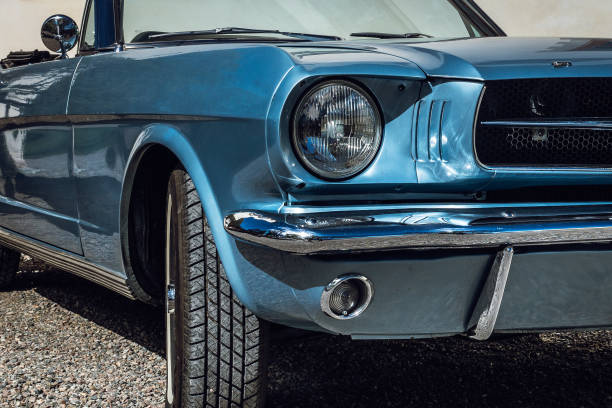Possuir um carro clássico é como ter uma verdadeira joia histórica sobre rodas, que combina uma beleza singular com um charme incomparável, frequentemente superando o apelo dos automóveis modernos. É fundamental empenhar-se na conservação e proteção dessa valiosa relíquia, seja um ícone renomado ou um fiel companheiro de longas viagens, para garantir seu desempenho excepcional e preservar sua estética impressionante.
1. Car in good condition
Although older cars are durable, they require more maintenance than new cars. Regular maintenance not only keeps your beloved car safe on the road, but also maintains its value and extends its lifespan.
2. Maintenance for your engine
The engine is the heart of any car and needs regular inspections to ensure it is in top condition. To keep your engine running properly, the oil needs to be changed, the spark plugs replaced, and the belts checked regularly.
3. Fluid replacement and inspection
Older cars are more susceptible to fluid leaks and wear. Engine oil, coolant, brake fluid and transmission fluid should be checked and replaced regularly to prevent major mechanical problems in the future.
4. Electrical system
Electrical problems, such as starting problems and fires, can be caused by poor wiring and old electrical components. This type of malfunction can be prevented by regularly checking the battery, alternator and wiring.
5. Protect paint
Using a high-quality car wax or sealant can help prevent the paint from fading and oxidizing, keeping your car looking shiny and new forever.
6. Internal maintenance
Regularly vacuuming and spotlessly cleaning your interior will keep it in good condition. Using fabric protector on car seats and carpets can also help keep them clean and prevent stains.
7. Maintenance dashboard
Over time, heat and UV rays can crack and discolor dashboards and interior trim. Regularly applying vinyl protection will keep your car’s interior looking new and protect the vinyl from sun damage.
8. Tire maintenance
Changing your tires regularly will help them wear evenly and extend their lifespan. It also improves vehicle handling and grip, especially older rear-wheel drive vehicles.
9. Tire pressure
Maintaining the correct tire pressure is important for safety and to save fuel. Check tire pressure regularly and add or remove air if necessary.
10. Brake system maintenance
When your brake pads wear out, your car becomes unsafe and difficult to park. Regular inspection and replacement of brake pads and flushing of brake fluid ensure optimal braking performance.
11. Brake fluid
Old brake fluid can cause brake fade and poor braking performance. Check the brake fluid level and color regularly and replace it if it becomes too low.
12. Flush the radiator
Over time, dust and other particles can build up in the radiator, causing the radiator to overheat and damaging the engine. These problems can be avoided by regularly flushing the radiator and checking for leaks.
13. Cooling fan
If the cooling fan is not working properly, overheating can occur, especially in older cars that have been driven a lot of miles. Regular inspection of your cooling fan and its components can prevent expensive repairs.
14. Exhaust system maintenance
Exhaust pipe leaks not only affect performance, but can also harm your health. You can prevent problems like carbon monoxide poisoning by regularly checking your exhaust system for leaks and taking breaks.
15. Versus hire a professional
If you have the right tools and knowledge, you can do a lot of maintenance at home. But some jobs can only be done by professionals. Knowing when to do something yourself and when to seek professional help can save you time, money and stress.
16. Maintenance tips
Keeping your old car in good condition doesn’t have to cost a lot. You can save on labor costs and keep your car in good condition by doing simple things like changing your oil, air filter and tires yourself.
FAQs
1. How often should I change the oil on my older car?
It is recommended to change your engine oil every 3,000 to 5,000 miles or every three to six months, depending on your driving habits and the type of oil you use.
2. What specific maintenance tasks should I prioritize for my older vehicle?
Yes, if you focus on regular fluid checks and changes, as well as brake and tire maintenance, you can help prevent major problems and extend the life of your older vehicle.
3. Is my old car worth investing in a professional inspection?
Of course. A professional inspection can help you identify potential problems early and avoid expensive repairs down the road, ultimately saving you time, money and frustration.
4. How can I protect my old car from rust?
Regularly cleaning and waxing the exterior and promptly addressing any paint chips or scratches will prevent rust. Additionally, storing your car in a dry garage can further prevent it from rusting.
5. What should I do if I notice unusual sounds or smells coming from my old car?
If you notice any unusual sounds or odors, it is best to have your car inspected by a qualified mechanic as soon as possible. Ignoring these warning signs can lead to more serious problems down the line.
Conclusion
Owning an old car is fun, but you have to put a lot of work and maintenance into it to keep it running well. By following these basic maintenance tips, you can ensure that your beloved vehicle continues to serve you faithfully for years to come.



